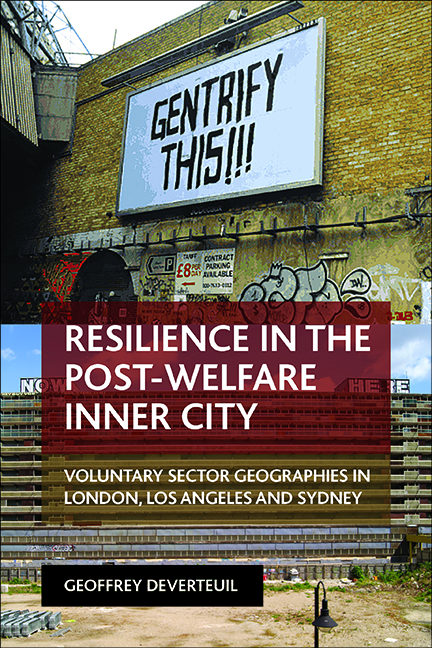 Resilience in the Post-Welfare Inner City
Resilience in the Post-Welfare Inner City Book contents
- Frontmatter
- Dedication
- Contents
- List of tables and figures
- About the author
- Acknowledgements
- Preface
- Part One Introducing resilience in the post-welfare inner city: conceptual and methodological considerations
- Part Two Case studies: spatial and social resilience in London, Los Angeles and Sydney
- Part Three Conclusions, critical resilience, commons and austerity
- References
- Index
eleven - The critical resilience of the residuals
Published online by Cambridge University Press: 10 March 2022
- Frontmatter
- Dedication
- Contents
- List of tables and figures
- About the author
- Acknowledgements
- Preface
- Part One Introducing resilience in the post-welfare inner city: conceptual and methodological considerations
- Part Two Case studies: spatial and social resilience in London, Los Angeles and Sydney
- Part Three Conclusions, critical resilience, commons and austerity
- References
- Index
Summary
I first argue that resilience has been ignored by critical geographers perpetually seeking spectacular evidence of transformation, however unlikely or sporadic. From critical approaches to disasters such as heatwaves (for example, Klinenberg, 2002, on how poor Chicago neighbourhoods avoided high death rates) to the survival of surplus populations (for example, Li, 2010, on why Kerala provides for poor people while Indonesia does not), ‘staying put’ (for example, Shaw, 2007, on the Block in Sydney's Redfern), and persistence of older immigrant enclaves (for example, Li et al, 2013, on the survival of Chinatowns in Boston, New York and Philadelphia), resilience both social and spatial has rarely been named or understood, much less interpreted in a critical sense. These examples suggest the pressing need to construe how things survive without disappearing, moving beyond inertia and persistence to embrace active, adaptive resilience under conditions of chronic and acute threats. Rather than one more study using Lefebvre's ‘right to the city’, perhaps it is time to apply concepts of resilience as a way to better grasp the full nature of urban struggle. Mitchell (2003) and Harvey (2012) both argued that the right to the city was the best normative platform to ensure the geography of survival, but resilience could be equally useful and sometimes more realistic for marginal vehicles like the voluntary sector, and in cases where overturning the system is not viable or possible; resilience more as a precursor, a prerequisite for eventual transformation. In this way, the crucial ‘resilience stage’ in the evolution of potentially transformative action may act as a foundation for survival and existence itself. That survival requires both social and spatial resilience seems obvious to geographers – to be, and a place to be – but relatively ignored by other resilience scholars who fail to connect the two.
Returning to each of the seven proposals generated in Chapter Two, I will reinforce the critical intention of the production of resilience – as a means to preserve crucial yet residual arrangements of social support in the inner city; as a means to capture the everyday and active nature of persistence; as evidence of caring and sustaining, but also coercive care and abeyance; and as a complex yet useful term, laying the foundations (but not more) for transformation, resistance and remaking.
- Type
- Chapter
- Information
- Resilience in the Post-Welfare Inner CityVoluntary Sector Geographies in London, Los Angeles and Sydney, pp. 219 - 238Publisher: Bristol University PressPrint publication year: 2015


